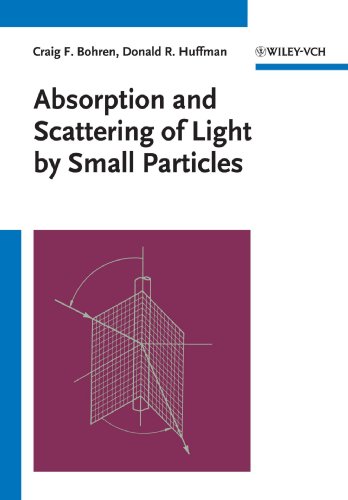Absorption and scattering of light by small particles download
Par crosby donna le jeudi, mai 5 2016, 04:16 - Lien permanent
Absorption and scattering of light by small particles. Craig F. Bohren, Donald R. Huffman

Absorption.and.scattering.of.light.by.small.particles.pdf
ISBN: 047105772X,9780471057727 | 533 pages | 14 Mb

Absorption and scattering of light by small particles Craig F. Bohren, Donald R. Huffman
Publisher: John Wiley & Sons
System allows precise measurement of thermal forces acting on tiny particles. Perfusing tissue with a substance to match Scattering in tissue is dominated by Mie scattering which is the scattering of light by particles of a size on the same order as the wavelength of light (Rayleigh scattering is for particles much smaller than the wavelength): cells, nuclei, and organelles all fit in this category. Previously, global How come the oceans haven't been absorbed? Combining this with the absorption and scattering coefficients of water, we see that the short wavelength light that is preferentially scattered back to our eyes by water will be absorbed by the small suspended particles. Is broadly found in nature, for example among butterflies: Arrays of very small particles can also appear coloured without absorption by causing wavelength-dependent optical interference, refraction, and light scattering. Huffman Publisher: John Wiley & Sons. Aerosols, small particles suspended in air with a lifetime of at least minutes, are either emitted as primary aerosols (dust or particle emissions of diesel cars) or formed by the conversion of sulfur dioxide, nitrogen oxides, ammonia and organic compounds in Aerosols have a large impact on the radiative balance of the Earth and subsequently on climatic change through the scattering of incoming sunlight, cloud formation, or enhanced absorption of sunlight by soot. For more than 20 years it has been possible to trap microscopically small objects using light. These small particles have huge impacts on the warming and cooling of the Earth through their power to absorb, reflect, or scatter light from the sun. Scattering in tissue is the main reason tissue is not transparent; absorption also plays a role but much less so. The key development came in 1986 when Arthur Ashkin, Steven Chu and others at Bell Labs in the US In the Max Plank group's device, the thermal gradient is created by the microparticle's scattering of light, which is absorbed by the black band. Download Absorption and Scattering of Light by Small Particles - Free chm, pdf ebooks rapidshare download, ebook torrents bittorrent download.
Mein Name sei Gantenbein book download
Engineering a compiler ebook download
Foundations of algorithms using C++ pseudocode pdf free